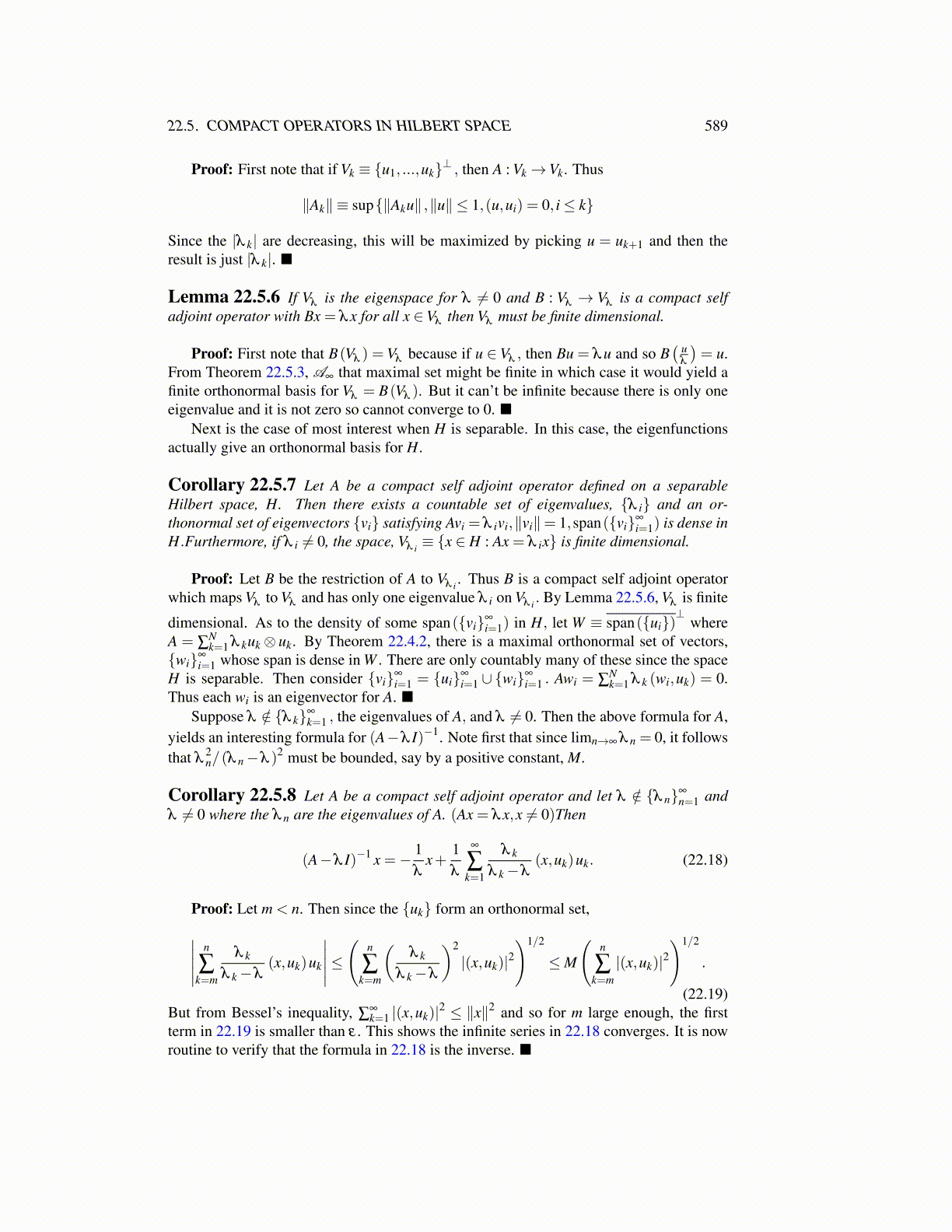
22.5. COMPACT OPERATORS IN HILBERT SPACE 589
Proof: First note that if Vk ≡ {u1, ...,uk}⊥ , then A : Vk→Vk. Thus
∥Ak∥ ≡ sup{∥Aku∥ ,∥u∥ ≤ 1,(u,ui) = 0, i≤ k}
Since the |λ k| are decreasing, this will be maximized by picking u = uk+1 and then theresult is just |λ k|. ■
Lemma 22.5.6 If Vλ is the eigenspace for λ ̸= 0 and B : Vλ → Vλ is a compact selfadjoint operator with Bx = λx for all x ∈Vλ then Vλ must be finite dimensional.
Proof: First note that B(Vλ ) = Vλ because if u ∈ Vλ , then Bu = λu and so B( u
λ
)= u.
From Theorem 22.5.3, A∞ that maximal set might be finite in which case it would yield afinite orthonormal basis for Vλ = B(Vλ ). But it can’t be infinite because there is only oneeigenvalue and it is not zero so cannot converge to 0. ■
Next is the case of most interest when H is separable. In this case, the eigenfunctionsactually give an orthonormal basis for H.
Corollary 22.5.7 Let A be a compact self adjoint operator defined on a separableHilbert space, H. Then there exists a countable set of eigenvalues, {λ i} and an or-thonormal set of eigenvectors {vi} satisfying Avi = λ ivi,∥vi∥= 1,span({vi}∞
i=1) is dense inH.Furthermore, if λ i ̸= 0, the space, Vλ i ≡ {x ∈ H : Ax = λ ix} is finite dimensional.
Proof: Let B be the restriction of A to Vλ i . Thus B is a compact self adjoint operatorwhich maps Vλ to Vλ and has only one eigenvalue λ i on Vλ i . By Lemma 22.5.6, Vλ is finite
dimensional. As to the density of some span({vi}∞
i=1) in H, let W ≡ span({ui})⊥
whereA = ∑
Nk=1 λ kuk⊗ uk. By Theorem 22.4.2, there is a maximal orthonormal set of vectors,
{wi}∞
i=1 whose span is dense in W . There are only countably many of these since the spaceH is separable. Then consider {vi}∞
i=1 = {ui}∞
i=1 ∪{wi}∞
i=1 . Awi = ∑Nk=1 λ k (wi,uk) = 0.
Thus each wi is an eigenvector for A. ■Suppose λ /∈ {λ k}∞
k=1 , the eigenvalues of A, and λ ̸= 0. Then the above formula for A,yields an interesting formula for (A−λ I)−1. Note first that since limn→∞ λ n = 0, it followsthat λ
2n/(λ n−λ )2 must be bounded, say by a positive constant, M.
Corollary 22.5.8 Let A be a compact self adjoint operator and let λ /∈ {λ n}∞
n=1 andλ ̸= 0 where the λ n are the eigenvalues of A. (Ax = λx,x ̸= 0)Then
(A−λ I)−1 x =− 1λ
x+1λ
∞
∑k=1
λ k
λ k−λ(x,uk)uk. (22.18)
Proof: Let m < n. Then since the {uk} form an orthonormal set,∣∣∣∣∣ n
∑k=m
λ k
λ k−λ(x,uk)uk
∣∣∣∣∣≤(
n
∑k=m
(λ k
λ k−λ
)2
|(x,uk)|2)1/2
≤M
(n
∑k=m|(x,uk)|2
)1/2
.
(22.19)But from Bessel’s inequality, ∑
∞k=1 |(x,uk)|2 ≤ ∥x∥2 and so for m large enough, the first
term in 22.19 is smaller than ε . This shows the infinite series in 22.18 converges. It is nowroutine to verify that the formula in 22.18 is the inverse. ■